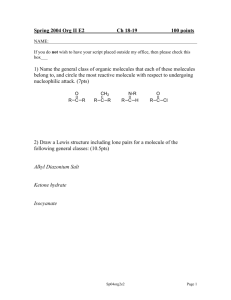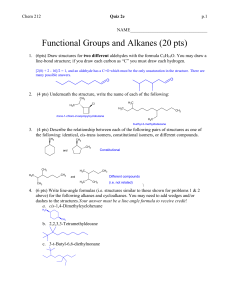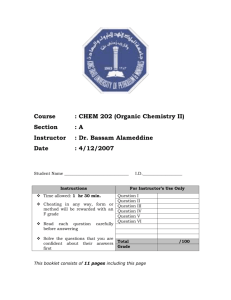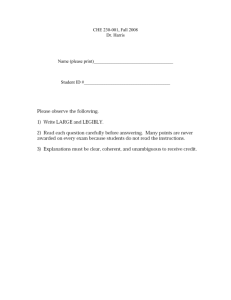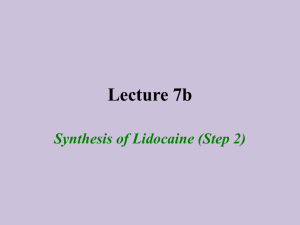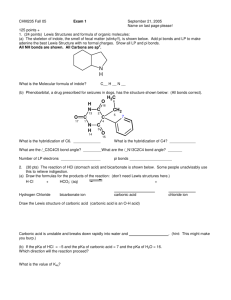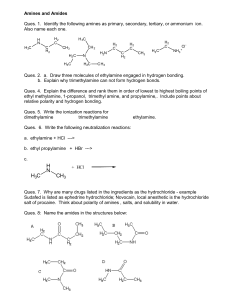experiment 7
advertisement
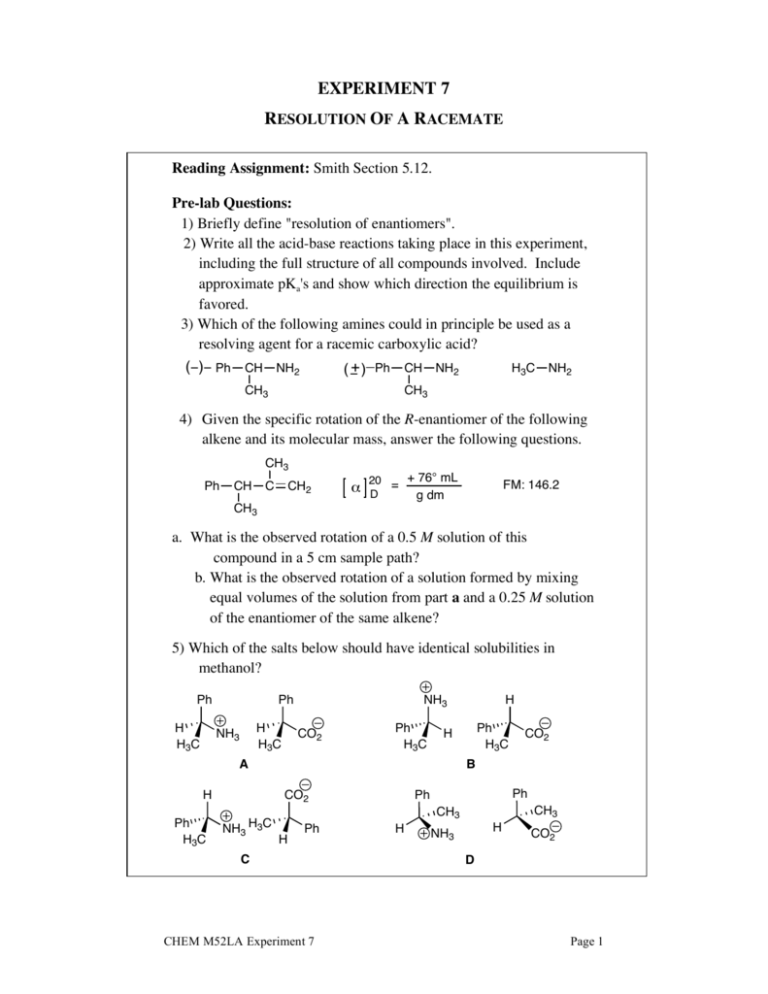
EXPERIMENT 7 RESOLUTION OF A RACEMATE Reading Assignment: Smith Section 5.12. Pre-lab Questions: 1) Briefly define "resolution of enantiomers". 2) Write all the acid-base reactions taking place in this experiment, including the full structure of all compounds involved. Include approximate pKa's and show which direction the equilibrium is favored. 3) Which of the following amines could in principle be used as a resolving agent for a racemic carboxylic acid? _ () Ph CH NH2 H3C NH2 ( + ) Ph CH NH2 CH3 CH3 4) Given the specific rotation of the R-enantiomer of the following alkene and its molecular mass, answer the following questions. CH3 Ph CH C CH2 20 = + 76° mL D g dm FM: 146.2 CH3 a. What is the observed rotation of a 0.5 M solution of this compound in a 5 cm sample path? b. What is the observed rotation of a solution formed by mixing equal volumes of the solution from part a and a 0.25 M solution of the enantiomer of the same alkene? 5) Which of the salts below should have identical solubilities in methanol? Ph H H3C Ph H H3C NH3 CO2 Ph H3C Ph H3C CO2 B Ph Ph CO2 NH3 H3C Ph H3C H A H H NH3 CH3 CH3 H Ph C CHEM M52LA Experiment 7 H H NH3 CO2 D Page 1 The two enantiomers of -methylbenzylamine have identical solubilities, but when a racemic mixture of -methylbenzylamine is treated with L-(+)-tartaric acid, it produces two diastereomeric salts that have sufficiently different solubilities that separation can be achieved by fractional crystallization. OH H 2N O OH + HO O HO L-(+)-tartaric acid a-methyl benzylamine (racemic) O O H3N O H 3N O OH OH + HO HO O O HO HO Less soluble salt The less soluble salt can be separated by filtration, and treatment of the concentrated aqueous solution with sodium hydroxide solution frees the amine, and allows you to isolate enantiomerically pure (-)--methylbenzylamine. O O H 3N O OH H 2N 2 HO HO O + OH HO O HO O O Procedure: In a small Erlenmeyer flask, mix 92.5 mmole of L-(+)-tartaric acid and 150 mL of methanol. Heat to just below the boiling point using a sand bath. Cautiously add 91.6 mmole of (±)--methylbenzylamine, mixing thoroughly. Cover, and place in your locker until the next laboratory period. NOTE: -Methylbenzylamine reacts readily with carbon dioxide and moisture in the air to form a white substance (a mixture of RNH3+ /–OCO2H, and RNHCO2–/RNH3+). Samples of the amine should always be stored in tightly stoppered bottles to prevent this from happening. Aromatic amines are toxic! Work in the hood and wear gloves! CHEM M52LA Experiment 7 Page 2 The following week: (Prismatic crystals should have formed as the solution cools. If needles form, warm the mixture to dissolve the crystals, and use a prismatic crystal from another student as a seed crystal.) Isolate the crystals by vacuum filtration, and wash them with a small amount of cold methanol. Place the crystals in an Erlenmeyer flask, dissolve in water, and add sodium hydroxide solution (10-50% by weight) to free the amine. Transfer solution into a separatory funnel, and extract with ether (3 times). Dry combined organic extracts with MgSO4, vacuum filter to remove drying agent, transfer to a clean, dry, tared round bottom flask, and rotovap to remove the solvent. Calculate the yield of your pure S-(–)--methylbenzylamine. (Careful here. What should your yield of one pure enantiomer be based upon?) Take a specific rotation of the product and calculate the optical purity of the sample (literature value for optically pure (–)--methylbenzylamine: []D = -30.5 in 95% ethanol, 0.1 g/mL.) Use a 1-dm polarimeter tube and a concentration of 0.1 – 0.3 g of sample per mL of 95% ethanol or absolute ethanol. Reference: 1. This procedure is adapted from: John A. Langrebe. Schoffstall, B.A. Gaddis, M. L. Druelinger, Theory and Practice in the Organic Laboratory with Microscale and Standard Scale Experiments, 4th Ed. Brooks/ColePublishing Company, 1993, p. 403. Post-lab Questions: 1) What would be the result of this experiment if D-tartaric acid was used in place of L-tartaric acid? 2) If 0.100 mole "recovered amine" had an [a]D = +20.35°, how many moles of (–)amine and how many moles of (+)-amine would there be in the sample? 3) If racemic tartaric acid was used instead of L-tartaric acid, what outcome might you expect? 4) An incompletely resolved mixture of (–)--methylbenzylamine and (+)-methylbenzylamine contains 75% of the (–)-enantiomer. What is the optical purity of the sample? CHEM M52LA Experiment 7 Page 3
